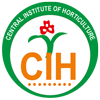DBT PROJECT UNDER CIH, NAGALAND
The Northeastern region being the centre of origin of citrus, a vast reservoir of citrus diversity largely exists in wild and semi-wild form. However, despite the large diversity of citrus and favorable conditions for its cultivation in the NE region, the productivity of the citrus is far below the national average. There is a need to carry out interventions through biotechnology tool to address various challenges being faced by citrus growers in the region, especially in the widely cultivated species such as Khasi mandarin and Sweet oranges.
The Central Institute of Horticulture, Nagaland is undertaking a DBT sponsored project entitled “Network Project for Establishment of disease free elite Khasi mandarin and sweet orange genetic stocks through shoot tip grafting (STG) and mass production of quality planting material for Northeastern states of India”
This project is based on the Hub and Spoke Model with Citrus Research Station, Tinsukia Assam as the Hub and CIH, Nagaland as one of its spoke centre. This project aims for mass production of disease-free quality planting material of citrus through shoot tip grafting (STG) for NE states of India.
The objectives of the Institute under DBT project;
| Sl. No. | Objectives | Timeline |
|---|---|---|
| 1 | Selection of elite mother/ candidate plants: The elite mother/ candidate plants of Khasi mandarin and sweet orange with superior horticultural traits will be selected from institutional sources/ farmers field. |
1st Year |
| 2 | Indexing of mother/candidate plants: Indexing of mother plants shall be done for detection of Citrus Tristeza Virus (CTV) and Citrus greening bacterium through PCR/RT-PCR and/or protein based enzyme linked immuno-sorbent assay (ELISA) |
1st Year |
| 3 | Submission of twigs collected from indexed candidate plants: The spoke centre will submit the twigs of indexed candidate plants to HUB for generation of STG derived plants (CRS, Tinsukia and partner institute IBSD, Imphal) for cleaning of virus & greening pathogen |
1st Year |
| 4 | Raising of root stock: Seedling of recommended root stock, viz., Rough lemon and other citrus will be raised following the rootstock nursery practices as per National Protocol & Standards. With a physical target of 40,000 nos. | 2nd Year |
| 5 | Establishment of protected Hi Tech scion bank/Foundation block: Protected Hi Tech scion bank/Foundation block of Khasi mandarin and Sweet orange will be established using the STG derived plants received from Hub and periodic indexing will be carried out. |
2nd Year |
| 6 | Large scale generation of planting material: Large scale generationof disease- free quality planting material of Khasi mandarin and Sweet orange will be done through conventional budding /leaf bud cuttage institutionally as well as through participatory approach involving certified/accreditated public & private sector horticultural nurseries of Assam. The State Deptt. of Horticulture will be involved for developing a robust quality planting material generation system in Mission Mode Approach. | 3rd Year |
SIGNIFICANT OUTCOME (2021-22 TO 2022-23)
- Survey of elite mother plants of khasi mandarin done in Mokokchung and Wokha district of Nagaland on basis of horticultural traits. Three khasi mandarins were identified and selected from Mokokchung district during the year 2021-22.
- Samples from selected candidate mother plants of khasi mandarin sent to Department of Biotechnology, AAU, Jorhat for detection of CTV & Citrus Greening bacterium through PCR/RT-PCR or ELISA. Result indicated the sample was Negative (-ve) of Citrus Tristezea Virus; however Greening bacterium found to be Positive (+ve).
- Twigs samples were collected from indexed candidate plants and submitted to IBSD however some complication occurred due to desiccation of samples during transit, therefore it was discussed that only grafted plants will be sent at the earliest.
- Raising of about 20,000 nos. of rough lemon rootstock of 6 to 8 months old rootstocks.
- Establishment of 2 nos. of screen house: 150 sq m each for raising disease free plants.
- Grafted around 500 plants to send to IBSD, Imphal for generation of STG derived plants.
- Published a research paper entitled “Effect of rootstock age, Integrated Nutrient Management and seasonal variations on conventional propagation method of khasi mandarin plants under polyhouse with respect to Nagaland” at The Pharma Innovation Journal (2022) Vol.11 (3) 727-733.
- Published one extension folder on “Propagation Techniques in mandarin orange and sweet orange with special reference to the northeast region”


 Selection of elite khasi mandarin mother plants from different orchards of Mokokchung district
Selection of elite khasi mandarin mother plants from different orchards of Mokokchung district 




